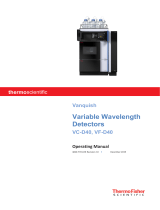Page is loading ...

Important Notes on Vanquish LightPipe Flow Cells
This is a supplementary document to the Operating Manual for Vanquish™ Diode Array
Detectors VH-D10 and provides the most important rules applying to LightPipe™ flow cells. For
detailed procedures and safety notes, refer to the Operating Manual for the detector.
NOTICE—Sensitive LightPipe Flow Cells
The handling of a LightPipe flow cell is fundamentally different to that of a conventional flow
cell. The LightPipe flow cell is fragile and sensitive to (back-)pressure, high temperatures,
contamination and clogging. This can result in damage of the flow cell, such as bursting of the
internal thin-walled fused-silica capillary.
To prevent damage, observe the following rules.
Installation
•Avoid exposure of the flow cell to mechanical shocks or vibrations. Do not let it hit hard
surfaces. Do not intrude the flow cell enclosure with any objects. Do not open the flow cell.
•Do not touch the optical ports of the flow cell or immerse them.
•If using multi-detector configurations, configurations that include a diverter valve, and
hyphenated techniques like LC-MS or fractionation after a LightPipe flow cell, install an
overpressure relief valve. The valve is intended to limit pressure in an error case. It is not
intended to limit overpressure events as a consequence of the system configuration and/or
instrument method not observing the flow cell pressure limit. Repetitive triggers due to
such instrument methods limit the ability of the valve to function correctly and reduce the
lifetime of the flow cell.
To protect the flow cell against overpressure and pressure shocks, observe the following:
- Set up instrument methods that ensure that the pressure inside the flow cell stays well
within its pressure specification (for information on how to determine the pressure inside
the flow cell of a configuration, refer to the Determining the Pressure inside the Flow Cell
section in the Operating Manual of the detector).
- Observe the pressure limit at all times.
- If the valve has opened, find, and resolve the root cause for opening and ensure that the
valve is tight before restarting measurements.
- If using mass spectrometers with diverter valves that offer a Make-Before-Break
connection, use this capability.
Doc. No. 4820.8311, Revision 2.0— January 2023 © Thermo Fisher Scientific Inc. All rights reserved.
All trademarks are property of Thermo Fisher Scientific Inc. and its subsidiaries. Page 1

Doc. No. 4820.8311, Revision 2.0— January 2023 © Thermo Fisher Scientific Inc. All rights reserved.
Page 2
Flow Connections
•Before you connect the flow cell to the flow path, make sure that you thoroughly flush the
modules in the system flow path upstream of the detector to waste.
•Use only clean Viper capillaries which were provided for the flow cell and which have been
properly protected by their cap before.
•Use only the waste line which was provided for the flow cell.
•Do not invert the flow cell inlet and outlet for normal flow cell operation. Inverting the flow
connections is only allowed for the back-flushing procedure that is described in the
manual.
•Use the flow cell only with a column or a filter frit connected in the flow path before the
flow cell.
Operation
•Handle flow cells always with care and use them only and strictly within their specifications
of up to 6MPa and 50°C.
•Never expose the flow cell to excessive backpressure. If a flow cell shows increased
backpressure or even blockage, back-flush the flow cell using only the back-flush kit.
Observe the instructions in the manual.
Shutdown – Short term
If the pump flow is interrupted and the lamp is turned on, protect the flow cell from the light of
the lamp: Close the shutter in the light path before the flow cell, or turn off the lamp.
Shutdown – Long term
If the pump flow is stopped for a longer time, or if the flow cell is to be shipped or stored,
observe the following:
•Flush the flow cell with a highly pure solvent that is miscible with isopropanol, such as LC/
MS-grade acetonitrile or methanol.
•Make sure that residual sample components, impurities from the column, aggressive
solvents or eluates with salt contents are completely flushed out of the flow cell.
•Fill the flow cell with pure isopropanol using the flushing and injection kit. The flow cell
should not be filled with pure water to avoid the growth of algae. If you want to fill the
flow cell with water, you need to add 10% HPLC-grade isopropanol.
•Using the wrong plugs in the flow cell inlet and outlet ports may damage the flow cell.
After removing the flow connections, protect the flow cell inlet and outlet ports only with
the plugs supplied with the flow cell. Furthermore, protect the inlet capillary and the waste
line only with the caps supplied with the capillary and the waste line.
/








